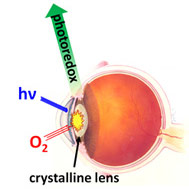

Monday - June 22, 2009
SLAC Today is
available online at:
http://today.slac.stanford.edu
In this issue:
New Insight into Cataract Formation
SLAC Celebrates
Juneteenth
Colloquium Today: Monte Carlo Particle Transport in Radiotherapy
 |
 |
|
Monday - June 22, 2009 |
New Insight into Cataract Formation Recent research conducted at the Stanford Synchrotron Radiation Lightsource has revealed a possible path to preventing age-related cataracts. A person's body experiences a continuous battle against the elements, with a constant barrage of oxidative stress attacking cells and their constituent parts. The body's natural defense mechanisms seek to prevent damage before it starts, but once a weakness in the armor presents itself, it can spread rapidly—and often unnoticed—until significant damage, including cataracts, occurs.
A research team led by Pierre Kennepohl of the University of British Columbia explored the basic photochemical processes of one particular amino acid that may lead to damage in lens proteins. Their studies suggest that
controlling the permeability of the eye's crystalline lens towards dioxygen
could prevent age-related cataracts. SLAC Celebrates JuneteenthMore than 100 people turned out last Friday to mark Juneteenth with a two-hour celebration in front of Building 41. It was the 20th Juneteenth celebration at SLAC, featuring food, music and a performance by the San Jose Mimes Troop. "We try to bring everyone together, just like we try to bring positrons and electrons together," said Juneteenth Committee Chairman Al Baker. "Food's good, music's good and everyone's happy." Baker also added his thanks to all of the Juneteenth committee members: Wanda Elliott, George Maclin, Hank Gray, Sandra Henderson, Mattie Pace, Sandra Pickrom, Rod Reape, Cliff Rogers, Michelle Smith, Pamela Wright-Brunache and Ellajean Polk. Colloquium Today: Monte Carlo Particle Transport in RadiotherapyThis afternoon, Stanford Associate Professor of Radiation Oncology Paul Keall and SLAC Research Software Developer Joseph Perl will present a SLAC colloquium: Monte Carlo Particle Transport in Radiotherapy: Mice to Humans. In radiation therapy, accurate estimation of dose to the tumor and surrounding structures is critical to delivering a useful treatment, with control of the tumor balanced against complications to normal tissues. Several techniques have been used to make these dose estimates, with increasing physics complexity being built into the models. But accurate calculations challenge current computational ability due to large variations of density and materials in human (and animal) anatomy. The most accurate method, Monte Carlo particle transport, has many interesting roots and current development activities at SLAC. Today's presentation will give a background to Monte Carlo simulation in radiotherapy and describe some of the ongoing projects in small animal radiotherapy, human radiotherapy and design of next-generation treatment systems. The colloquium will take place at 4:15 p.m. in Panofsky Auditorium. It is free and open to all. Next Monday, Stanford Professor Shan Wang will present "Nanomagnetic Materials and Devices for Cancer Diagnostics and Efficient Power Delivery." |
Events
Access (see all)
Announcements
|
|
| | ||
|
|
||
 <%
Response.AddHeader "Last-modified", getArticleDate()
'Response.AddHeader "Last-modified","Mon, 01 Sep 1997 01:03:33 GMT"
'Monday, December 06, 2010
%>
<%
Response.AddHeader "Last-modified", getArticleDate()
'Response.AddHeader "Last-modified","Mon, 01 Sep 1997 01:03:33 GMT"
'Monday, December 06, 2010
%>View online at http://today.slac.stanford.edu/. |
||